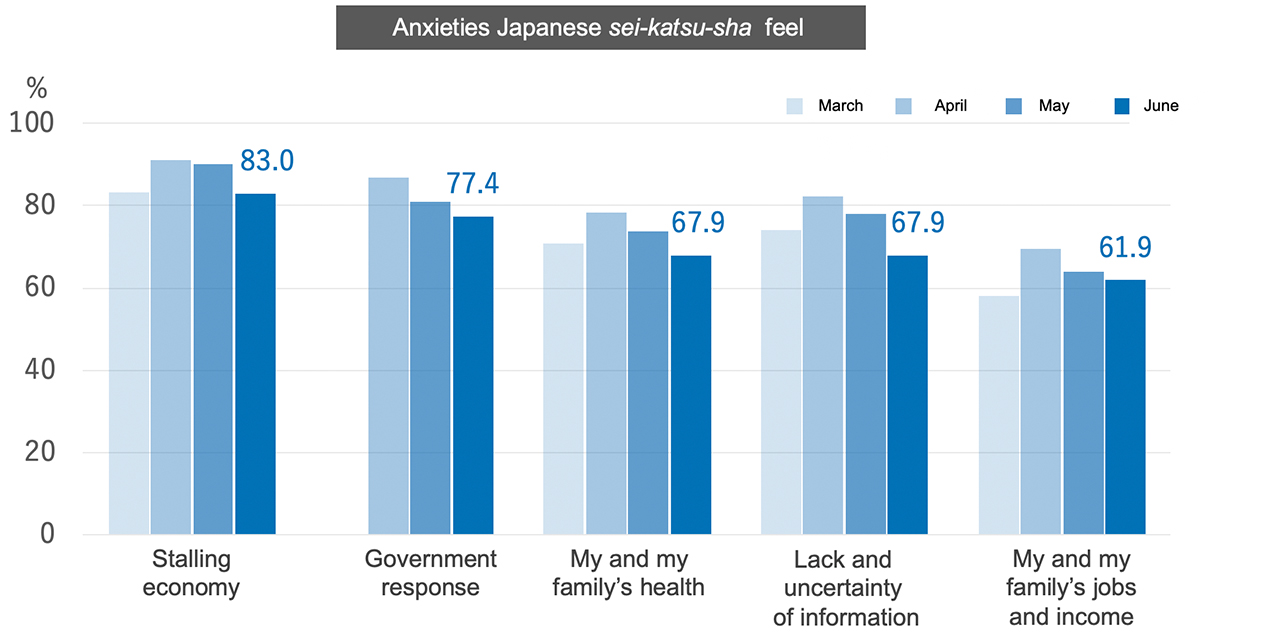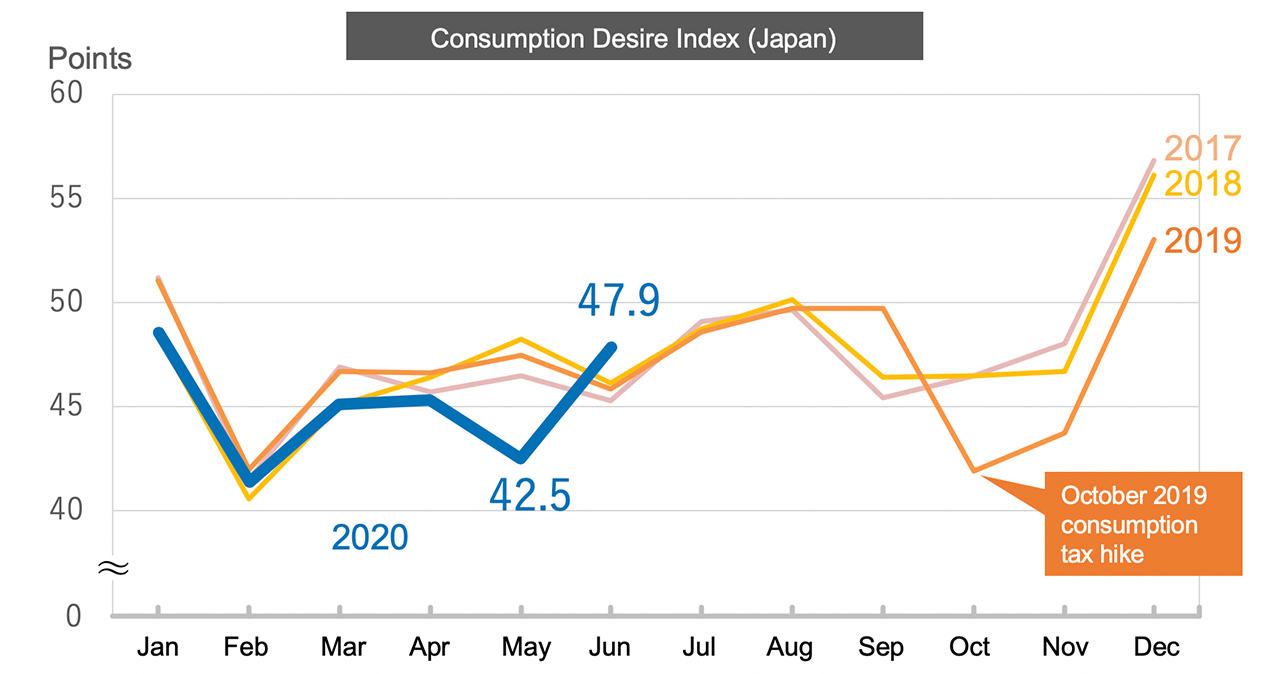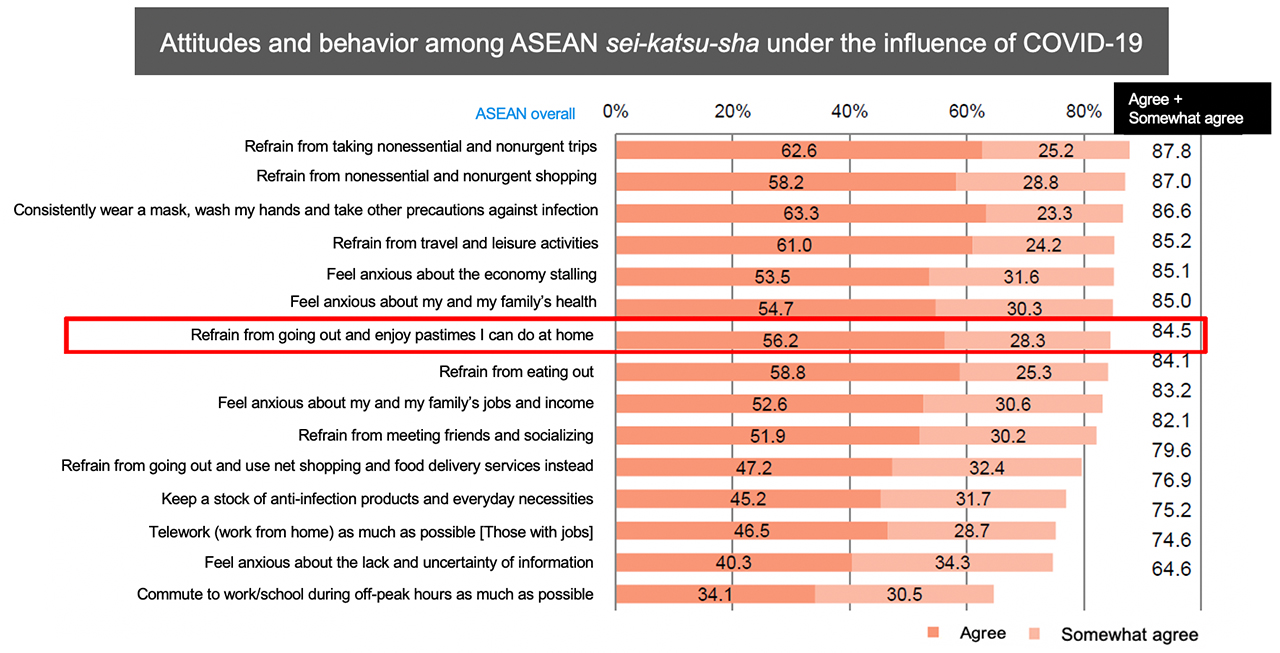Hiroshi Hori of Hakuhodo Institute of Life and Living (HILL) reports on the most notable findings of the Survey of Sei-katsu-sha Concerning COVID-19 in Japan, China, and the ASEAN
Japan in the “under COVID-19” period
I’ll introduce findings from the Japanese survey first. The survey was conducted online on 1,500 males and females aged 20–69 in the Greater Tokyo, Hanshin and Greater Nagoya areas four times—March 5–9, April 2–6, May 7–11, June 4–8. Immediately obvious were changes in sei-katsu-sha as they explored a new normal as Japan transitioned from being “under COVID-19” from March to June to the current “with COVID-19” period.

When we asked respondents about their anxieties at present, worries about the economy stalling, the lack and uncertainty of information and their and their family’s health all increased temporarily in April and have been decreasing since May.
In regard to behaviors Japanese people were voluntarily abstaining from, around 90% were refraining from going out, partaking in leisure activities, eating out, and socializing in May, but these numbers started dropping in June, after the Japanese government lifted the state of emergency across the country in late May.

Since June, Japanese sei-katsu-sha appear to be trying to go back to their normal lives, but there are also aspects where that is not the case. When we asked respondents about the behaviors they have started or increased in response to the spread of COVID-19, scores for Upgrading my home environment (telecommunications environment, etc.), for instance, have grown in each survey.
Despite the lifting of the state of emergency, it appears that an increasing number of sei-katsu-sha think that teleworking and improving the quality of the time they spent at home will be essential in the future. Additionally, the belief that having just one source of income might be risky to their future lives is likely to be behind the increased scores for Started/Considering a second job and Investing. A picture emerges of sei-katsu-sha who see the new normal is nothing like the old normal and are adjusting their behavior accordingly.

The data above is from HILL’s monthly Consumption Desire Index. We asked how respondents rated their desire to buy products and use services in the coming month if peak desire rated 100 points.
The index is affected by seasonal variation and follows basically the same trajectory every year, but may respond differently in the case of major events, such as the consumption tax hike last year.
The Consumption Desire Index plunged in May, but rebounded significantly in June, recording its highest May score in five years—a swell in sei-katsu-sha’s appetite to consume that could be described as “consumption magma.”
In terms of the categories respondents particularly want to spend in, consumption desire is rising especially in categories related to going out. There were notable increases in eating out, leisure activities, travel, hairdressing, fashion and the like, with the number of categories that returned higher consumption desire itself also increasing.
However, tightening of purse strings due to the coronavirus remains evident. Looking at free responses, while the number of positive responses on consumption like “I want to relieve stress” are increasing, of those that gave negative responses, many provided reasons such as “Because my income has decreased,” and such fundamental consumption-cooling factors are actually on the rise.
So rather than pent up “consumption magma” simply erupting, there also appear to be factors that will put the brakes on future consumption.
Chinese sei-katsu-sha more dispassionate and longer-term minded than expected
Next, I’ll highlight Hakuhodo Institute of Life and Living Shanghai (HILL Shanghai)’s report on the situation in China, which entered the “with COVID-19” period earlier than elsewhere. As the coronavirus situation calms down and economic activity resumes in earnest, is “payback consumption” taking place among Chinese sei-katsu-sha?

First, let’s look at consumer trends in China using the Consumption Barometer Survey, an internet survey conducted by HILL Shanghai every month.
As we can see, the consumption index, which was tracking at around 70 points range, plunged when the COVID-19 outbreak became serious in February, then immediately rebounded to previous levels.
Looking at items consumed in this period, in January and February, when the virus was spreading, consumption of life-supporting items like food, beverages and medicines exceeded previous year levels with communications, office products and daily necessities then doing so in March, and cigarettes, alcohol, cosmetics and cars doing so in April.
When we asked about the situation around town, we learned that eating out is back on the menu and entertainment facilities have reopened, but some cinemas, schools and other facilities remain shuttered.
During the May Day holiday, which equates to Golden Week in Japan, many Chinese sei-katsu-sha enjoyed outdoor leisure activities, but the 115 million travelers across China was well down on the 195 million recorded during the corresponding 3-day holiday last year, indicating that economic activity has not yet fully recovered.
Protecting themselves and striking first

Looking at changes in the behavior of Chinese sei-katsu-sha, even though the spread of COVID-19 is subsiding now, respondents are still wearing masks when they go out, refraining from traveling and from making major purchases, and active consumption behavior such as spending money to buy something better and buying something they had been denying themselves is low. This trend has not changed significantly compared to April and May, and there is no evidence of any major shift in behavior that could be called “payback consumption.”
From an interview survey conducted by HILL Shanghai, it is apparent that sei-katsu-sha are still conscious of protecting themselves, with responses such as: “I clean surfaces in my home with disinfectant and am careful to sterilize my grandchild’s toys” (female, 60s, Shanghai) and “Even though I traveled during the May Day holiday, I avoided the peak period, reduced the number of days and otherwise avoided the risk of infection” (female, 30s, Guangzhou).
Also, such responses as “I’ve changed my old shopaholic ways and reduced my impulse buying, and now put the money into insurance and savings,” (female, 20s, Shanghai), suggest the advent of a desire to save, and “I’m working to boost my skills and gain qualifications,” (male, 30s, Guangzhou), suggest that this new desire is occurring in learning.
This suggests that previously “enjoy-the-here-and-now” Chinese sei-katsu-sha are taking a surprisingly cool and long-term view of things and shifting their outlook significantly toward preparing for the future.
An ASEAN that hasn’t forgotten to smile, even in the midst of the COVID-19 crisis
So how are things with sei-katsu-sha in ASEAN countries during the COVID-19 crisis?
Let’s have a look at a study conducted by Hakuhodo Institute of Life and Living ASEAN (HILL ASEAN). The internet survey was conducted March 27–31, 2020 in the six countries Thailand, Indonesia, Singapore, Malaysia, Vietnam and the Philippines.
Firstly, we can preface this by saying that there were major differences in the attitudes and behavior of sei-katsu-sha between the countries due to differences in the impact and stage of the coronavirus in each.

In things ASEAN sei-katsu-sha feel were impacted by the COVID-19 outbreak, the top items were Transportation method and Meals in Thailand, Relationships with people around me in Indonesia, Travel/Leisure in Singapore, Medical care in Vietnam, and Communities in the Philippines, indicating huge variations between countries in how sei-katsu-sha viewed things depending on the environment in their country.
Looking at the scores for ASEAN overall, the coronavirus crisis has undoubtedly had a massive impact on ASEAN sei-katsu-sha, with some 91% of respondents saying COVID-19 is the event that has impacted them the most.

What I’d like to point out here is the cheerfulness of ASEAN sei-katsu-sha, who don’t forget to have fun, even if they are wearing masks and taking other precautions against COVID-19, as evidenced by the 85% that agree that they Refrain from going out and enjoy pastimes I can do at home.
Promoting anti-infection measures in a cheerful manner is a feature of the ASEAN response. For instance, in Thailand, the Bangkok Mass Transit System made a splash when employees made a singing and dancing video to spread the infection prevention message.
We hear that although they rarely cooked for themselves previously, often eating out or getting take away, many ASEAN sei-katsu-sha have taken to cooking for themselves and exercising following the outbreak of COVID-19. Thus, a picture emerges of ASEAN sei-katsu-sha cheerfully trying to get through this tough situation while enjoying time with their families and entertainment and other pastimes they can do at home.
We also heard that as a result of COVID-19, platforms for helping people who have taken an economic hit have been launched and that the number of sei-katsu-sha with a mind to take care of others and provide mutual assistance, whether directed at their country or the people around them, has increased. The Happiness Box initiative in Thailand, through which people share food, detergent, water and other goods to support people in their communities suffering economic hardship as a result of COVID-19, for instance, is illustrative.
I thought that Japan could learn a lot from the way ASEAN people try to get through hardship by offering mutual support and remaining cheerful, even during the COVID-19 crisis.
We have looked at sei-katsu-sha in Japan, China and ASEAN during the coronavirus outbreak.
The spread of COVID-19 has without a doubt changed sei-katsu-sha’s attitudes and behavior significantly. But responses have varied significantly depending on the environment and culture in each country. By understanding these sei-katsu-sha perspectives, perhaps we will be able to foresee changes yet to occur in other societies.
Hakuhodo Institute of Life and Living, HILL Shanghai and HILL ASEAN will continue to monitor changes in sei-katsu-sha attitudes and behavior during the pandemic.

Top row from left: Tetsuo Yamamoto (HILL Shanghai), Hiroshi Hori (HILL), Daisuke Uchihama (HILL)
Bottom row from left: Yuko Ito (HILL ASEAN), Tomoka Takada (HILL ASEAN), Zhong Ming (HILL Shanghai)










